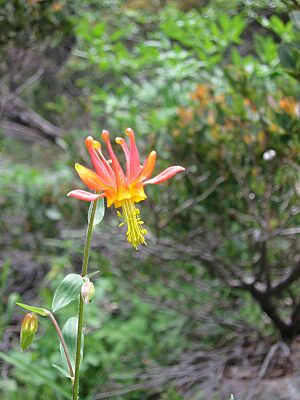Crimson columbine facts for kids
Quick facts for kids Crimson columbine |
|
|---|---|
 |
|
| Scientific classification | |
| Genus: |
Aquilegia
|
| Species: |
formosa
|
The crimson columbine (scientific name: Aquilegia formosa) is a beautiful wildflower found in western North America. It's also known as the western columbine or sometimes the "red columbine." You can find it growing from Alaska all the way down to Baja California, and east into states like Montana and Wyoming.
Contents
About the Crimson Columbine Plant
The crimson columbine plant usually grows to be about 60 centimeters (about 2 feet) tall. However, it can be anywhere from 20 to 80 centimeters (about 8 inches to 2.5 feet) tall.
Its bright Flowers can be seen from April to August, depending on where they grow. These flowers are about 5 centimeters (2 inches) long and are a mix of red and yellow. The outer parts of the flower, which are red or orange and spread out, are actually called sepals. The yellow parts inside are the true petals.
The petals have special parts called spurs. These spurs help attract the plant's pollinators. Sphinx moths are important pollinators for this plant. Hummingbirds also love to visit these flowers, especially in gardens!
While the flowers are sweet and can be eaten, the seeds are dangerous and should never be eaten. Most other parts of the plant can also be harmful if eaten.
Where the Crimson Columbine Lives
The crimson columbine grows in many different places within its natural range. You can find it in chaparral areas, oak woodlands, and forests with mixed evergreen or conifer trees.
It does not grow in very dry desert areas. You also won't find it at very high altitudes, above 3,300 meters (about 10,800 feet). It is also not found in the Central Valley of California. This plant prefers places that are moist, like along the banks of streams.

Native American Uses
Some Plateau Indian tribes used the Aquilegia formosa plant in interesting ways. They would use it to make a type of perfume. Different Native American tribes also used parts of this plant for traditional medicine.
What Its Name Means
The name Aquilegia comes from a Latin word, 'aquila', which means 'eagle'. It might also come from old German words like 'Acheleia' or 'Akelei'. This name refers to the flower's spurs, which look a bit like an eagle's talons.
The second part of the name, formosa, is also from Latin. It means 'handsome', 'beautiful', or 'well-formed'. So, the full name means something like "beautiful eagle-like flower"!
See also
 In Spanish: Aquilegia formosa para niños
In Spanish: Aquilegia formosa para niños

